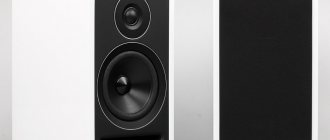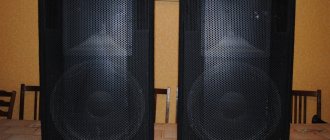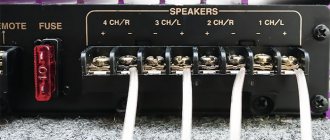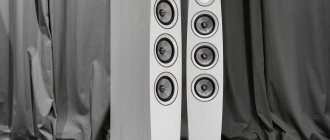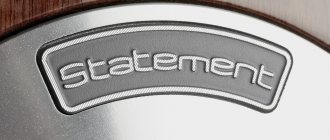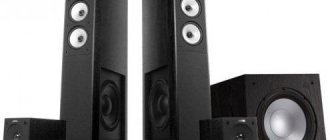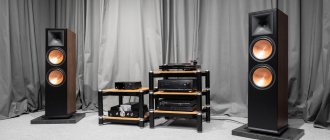It’s even surprising that one of the oldest acoustics manufacturers’ Heritage line consists of only three models, two of which were released for anniversaries. However, perhaps this is as it should be, because the Wharfedale company works for a wide range of music lovers, creating modern, technologically advanced and affordable speakers for them.
When it comes to the 85th anniversary, it is simply impossible to do without a short excursion into history. So, the company that Gilbert Briggs founded in 1932 was called Wharfedale Wireless Works. Doesn't it sound very modern?
Wharfedale is the name of an area in Yorkshire, the valley of the River Wharfe, which, like any other, cannot be entered twice. Wireless in those days was a simple radio, for listening to the broadcasts of which loudspeakers were produced. Current wireless technologies are based on the same physical process - the propagation of electromagnetic waves - but there are still more differences here than between humans and monkeys, who also have a common ancestor.
So, a comparison of the limited-edition anniversary speakers with their prototype Denton 3 speakers from the 70s indicates that many revolutionary changes have occurred in such a conservative segment of the Hi-Fi industry as the production of acoustics.
Basically, they are associated with the emergence of new materials that make it possible to bring real structures closer to theoretically ideal schemes for optimal radiation of sound waves. For example, the Denton 85th has a lightweight and rigid Kevlar mid/bass driver equipped with a molded basket, providing sound in the range for which their “grandfather” required two drivers with paper cones.
The tweeter with a woven fabric dome is very similar to the old one. It is also hidden behind its own metal grille, and its engine uses a ferrite magnet rather than the more modern neodymium magnet. This is done to make the highs smoother, and metal mesh can also have a similar effect on the highs.
A noticeable feature of the case is the slightly recessed front panel. When the protective grille, made of old-fashioned fabric, is installed in place, the speakers take on a complete retro style. However, for modern speakers, developers create enclosures without protruding elements, on which secondary diffraction sources of radiation are so fond of appearing.
However, the quality of the cabinets and their finishing with natural veneer does not cause any complaints. There are two bass reflex ports on the rear panel, and for connection to the amplifier there are two pairs of high-quality connectors, which allows the use of bi-wiring and bi-amping circuits - a rare option for bookshelf speakers.
Back to the Future
When tested as system partners, the Wharfedale Denton 85th featured a Naim NDX 2 network player, as well as a Quad Vena II integrated amplifier in a wood-finished cabinet that looked very much like the speakers. This design does not at all imply the absence of modern technologies on board. It works with both analogue and digital signals - including those coming from a PC (PCM up to 24 bit/384 kHz, DSD up to DSD256) - and is also equipped with a Bluetooth module (with aptX). Moreover, its output power is 2x65 W at 4 ohms, which is quite enough for bookshelf speakers.
From the photographs it is hardly possible to judge how the Denton 3 played. Most likely, their descendants significantly surpass them in detail, dynamics and transparency of sound - it simply cannot be otherwise, even if it seems to someone that the grass was greener before. But, apparently, they had something that made them popular and worthy of such a long memory.
The Denton 85th is characterized by smoothness, warmth and expressiveness in the presentation of musical material. The low range is deep, weighty and confidently controlled, which is impressive considering the bookshelf form factor of the speakers. The scene is large-scale, the focus of the images on it is clear.
However, there is also originality in the interpretations of familiar compositions. Ella Fitzgerald's album "Clap Hands, Here Comes Charlie!" sounded divine, with a very reliable effect of presence, subtle and accurate transmission of the nuances of her vocals, penetrating directly into the soul. The stage is realistic, filled with air, the instruments on it are clearly visible, although they are relegated to the background a little further than usual.
Something similar was observed when the Dave Brubeck Quartet played the composition “Take Five.” The saxophone's voice is velvety, rich, expressive, the piano clearly and assertively leads its part, but the drums and percussion are somehow faded against their background, although usually the drum roll is presented more prominently and fervently.
But if you sit closer and turn the speakers so that their acoustic axes exactly cross on the listener’s head (and for this the stands should be higher or the chair lower), then everything falls into place. The tonal balance is evened out, the highs become louder and more detailed, the sound is sharpened and filled with details. The languor and fluidity almost completely disappear from it, but it becomes more elaborate, detailed and dynamic in a modern way.
Even recordings of symphonic music were played quite convincingly. "Four Sea Interludes" by B. Britten is performed on a large scale, with a clearly defined and organized scene, impressive changes in volume and excellent intelligibility in quiet fragments. Just great for bookshelf speakers.
The high directivity of the sound is to be expected from speakers with a wide front panel, but the listener has a choice: smooth, slightly smoothed sound in a retro style for songs from the past (for example, from the album “Machine Head” by Deep Purple), which are presented in a very authentic way, or more direct and fast for songs like Michael Jackson's "Xscape."
Quad Vena II amplifier with Wharfedale Denton 85th Anniversary acoustics
If you are mentally mature enough to buy a Hi-Fi system, but the price of full-length components is still daunting, and microsystems seem frivolous, take a closer look at this kit. Yes, this couple looks like they made it back in the days when Led Zeppelin was recording their first album, but the filling of this vintage is serious and modern.
Any equipment from the “golden era” of Hi-Fi today collects a lot of likes from social network users. For example, open our Instagram, enter the hashtag #vintagehifi or #oldhifi into the search field and you will see how much old playback equipment is held in high esteem even by the younger generation of music lovers. But this nostalgic love is platonic in nature - only fanatic collectors are willing to spend money on separate components released several decades ago. No matter how cute the equipment from that era is, it is problematic to assemble a functional stereo system from it. Equipment that is morally and physically outdated requires expensive restoration, and sometimes complex modifications to modern standards.
And for the next anniversary, the company made another pair of systems in the traditions laid down by the founder of Wharfedale, Gilbert Briggs.
All the more interesting is any option based on new “old” components. I don’t mean something that is only externally stylized as antique, but a technique that among music lovers is usually called “restomod.” This is when a certain iconic design is taken as a basis, internally it is thoroughly (or completely from scratch) redesigned to accommodate a modern element base and new functions, and externally it retains its historical face. The kit that we are going to listen to today fits this description quite well - these are typical restomods, and made not at the artisanal level, but at the factory level.
By the way, we have already tested a similar combination - a Quad Vena integrated circuit/DAC in a “mounted-in” case, trimmed with wood, with Wharfedale Diamond floor speakers, which are surprisingly suitable in appearance. The new system combines retro motifs with the most advanced features in an even more interesting way. And let's start, perhaps, with acoustics - the Wharfedale Denton 85th Anniversary bookshelf.
Almost ten years ago, when the British company was preparing to celebrate its 80th anniversary, it decided to re-release one of its legendary compact systems. The anniversary model was called Denton 80, collected a lot of flattering reviews and actually marked the beginning of the new Heritage series (today it includes the Linton model). And for the next anniversary, the company made another pair of systems in the traditions laid down by the founder of Wharfedale, Gilbert Briggs. These are quite large and weighty monitors, the housings of which reach an internal volume of 13.5 liters and a weight of 9 kg.
There is no need to comment on the execution and finishing of the Denton 85th Anniversary - the almost square proportions, recessed face shield, rectangular tweeter flange and dustproof grill made of fabric with a textured large weave directly refer to the design of the Denton 3, which were produced back in the 70s. But unlike the original, the new monitors are not closed, but have a bass-reflex design (both ports are at the back), and they are made according to a two-way rather than three-way ideology.
There are undeniable advantages to this approach. First of all, the additional division into stripes and the resulting phase shifts are eliminated.
Why? The answer is simple: technology. Modern Kevlar diffusers, the development of which Wharfedale ate the dog, make it possible to combine in one speaker the characteristics of both a powerful low-frequency driver (large radiation area, proper membrane rigidity) and a specialized tweeter (low weight of the moving system, high responsiveness to rapid vibrations). There are undeniable advantages to this approach. First of all, the additional division into stripes and the resulting phase shifts are eliminated. At the same time, the working band of the head remains as wide as that of a pair of low-frequency/mid-frequency drivers. The 17-cm midwoofer Denton 85th Anniversary, for example, easily plays down to 40 Hz (at a level of -6 dB), and passes the baton to the tweeter relatively high, at 3100 Hz, which makes the task of the silk tweeter much easier. And so, I believe, it was made exactly according to the old methods - it has not only traditional ferrite in the magnetic system, but also a less convex dome, is devoid of ferromagnetic liquid in the gap, etc. (these are my guesses, but there are reasons for them - not accidentally the emitter is covered with a steel mesh, and the power supplied to the speakers is limited to 120 watts).
The easiest way to imagine the Quad Vena II integrated circuit/DAC is this: it’s a new model from start to finish, but in a familiar retro case with two front panel options and three additional colors for the main “box.” External differences boil down only to the location of the LED indicators (previously they were located directly in the input selector buttons). In the digital path, there is a new USB receiver capable of accepting audio data at up to 384 kHz and DSD256 streams, followed by a more advanced ES9018K2M DAC (32-bit HyperStream ESS architecture, Time Jitter Eliminator technology). The latter significantly adds points to “Vienna”, because the first model on the Crystal CS4398 only worked with data up to 24 bit/192 kHz. The analogue path has also been redesigned. A high-quality MM phono preamplifier and a separate telephone amplifier module have been added to it. Volume is now controlled by a motorized ALPS potentiometer, the power supply features a new 200VA toroidal transformer, and the capacitor buffer has been increased to 2 x 15,000uF. Finally, 65-watt terminals operating in class AB and made using proprietary circuit design have also undergone modifications - with harmonics less than 0.0005% they now produce three times more power.
The analogue path has also been redesigned. It has a high-quality MM phono preamplifier and a separate telephone amplifier module added to it.
Knowing that Quad always managed to bring the analogue path to perfection, and the weak point of the previous model was precisely the digital section, I tried to focus on it when listening. But it turned out a little differently. Acoustics made adjustments to the test script. Small “artificial” tones in the 1 - 2 kHz region (typical of Kevlar diffusers, by the way) - that’s all I can blame on the new Denton 85th Anniversary. And they will certainly become less noticeable over time, when all the elastic elements of the moving system warm up properly.
These speakers should definitely be placed in the room fairly close to the wall (but not to the corners!), regardless of the rear location of the ports. The bass acquires both powerful “weight” and excellent speed - at first it is even difficult to attribute such a presentation to any school, because it has both “monitor” bite and solid “floor” volume. At the same time, the scene is also reproduced coolly - it slightly loses the spectacular expressiveness of the plans in depth, but the three-dimensionality does not disappear anywhere - the apparent images are not flat, they are precisely localized and placed between the foreground and background. With maximum precision, place the speakers at the listening point and put dustproof nets on them - you will hardly lose the sharpness of the transmission of cymbals and brushes, but the reproduced space will become even more accurate and believable, since precise localization will appear at the edges of the stage and even beyond it.
At first, it’s even difficult to attribute such a presentation to any school, because it has both a “monitor” bite and a solid “floor” volume.
It’s probably worth adding about acoustics. With the density of the “barrels” and a rather dry, but very legible texture in the transmission of double basses, they remind me of the best old speakers with 20-25 cm paper bass drivers. They are not the standard of linearity at high frequencies, but after just five to ten minutes of auditory adaptation, their sound begins to seem quite balanced and neutral, and this is a sure sign that real frequency response deviations are minimal and are not at all critical for listening. Microdynamic resolution, reproduction of “wood” or “metal” shades, and the purity of noise trails are excellent. I like this kind of reproduction much more than modern systems with a neutral, but somehow filtered or smoothed sound. “Old school” allows you to discern more information, better feel all the differences in recordings from different years, and get special pleasure from those that were recorded half a century ago on not the most advanced equipment. Liveliness and clarity are the strength of the entire system.
But I didn’t notice any genre specificity. The Denton 85th Anniversary's huge headroom in low-end dynamics allows the acoustics to cope with anything - the ultra-dynamic Sepultura, experimental electronics, and even new school rap with its destructive bass (at least the acoustics remain unscathed after it). High resolution in the middle is the door to jazz and classical, and the naturalness and richness of the upper register is a pure thrill when listening to acoustics and vocals.
Keep in mind that Vena II reacts to changes in the polarity of the power outlet and the quality of the power cable.
And all this is fully demonstrated by the Quad Vena II. Not flashy, but confident, clean and airy sound - this is in the corporate tradition. Sometimes the amplifier seems harsh, but this only manifests itself in those recordings where the sound was intended to be that way. And sometimes rough, raw or lacquered shades appear in his playing, but this also cannot be blamed on the tract - you simply hear better all the instrumental shades and nuances of mixing, and not what arose in the amplification stages due to insufficient damping of the acoustics (with Our couple is in complete order with this). Keep in mind that the Vena II responds to power socket polarity and cable quality with the same sensitivity as a true audiophile amplifier. And he can no longer be accused of some dry or harsh shades of digital origin. Although the detail when playing back via the digital path with the new DAC began to stand out more clearly, there is no unpleasant deliberateness in it - even when the source is a cheap smartphone connected via Bluetooth with a standard codec, and inevitable compression artifacts appear in the sound.
Need more arguments? If so, look for them yourself by taking out a calculator and working out how much any alternative hi-fi system with full-size mid-range components would cost. Otherwise, you simply won’t get the same musicality and precision that pleased this British couple.
SYSTEM
- Sources laptop Apple MacBook Air A1465
- smartphones Nokia Lumia 930, iPhone 8 and Redmi 6A
- digital InAkustik Referenz High Speed USB 2.0
Quad Vena II
Manufacturer: Quad Electroacoustics Limited/IAG Group (UK)
www.quad-hifi.co.uk
Inputs: 2 pairs of linear RCA, Phono MM, 2 TOSLink, Coax, USB Type-B, USB Type-A || Outputs: analog PreOut RCA, TOSLink, coaxial RCA, Phones 3.5 mm || Input Impedance RCA/Phono: 10/47 kOhm || Supported bit depth: PCM up to 24 bit/96 kHz (for S/PDIF inputs), up to 32 bit/384 kHz and DSD256 (via USB) || Output Power: 2 x 45 W (at 8 ohms), 2 x 65 W (at 4 ohms) || Signal-to-noise ratio: >108 dB || Distortion Level: Less than <0.0005% (30W, 8ohms) || Frequency range: 20 Hz – 20 kHz (+/- 0.5 dB)|| Bluetooth: A2DP, aptX, SBC || Maximum power consumption: 750 W || Finish: matt grey, white, mahogany, black or white lacquer || Dimensions (H x W x D): 94 x 313 x 302 mm || Weight in metal/wood: ?6.1/7.5 kg || Price: in any finish: 85,490 .
Wharfedale Denton 85th Anniversary
Manufacturer: Wharfedale/IAG Group Ltd (UK)
www.wharfedale.co.uk
Configuration: 2 emitters, 2 bands || Acoustic design: bass reflex || Reproducible frequency range: 45 – 20,000 Hz (with unevenness +/-3 dB) || Sensitivity: 88 dB || Maximum SPL: 95 dB || Nominal/Minimum Resistance: 4/3.8 ohms || Recommended amplifier power: 20 – 120 W || Finish: Walnut || Dimensions: 240 x 340 x 287 mm || Weight: 9 kg (each) || Price per pair: 51,390 .
share
Tags: QuadQuad Vena IIWharfedaleWharfedale Denton 85th Anniversary
Bookshelf speakers WHARFEDALE Denton 85th Antique Walnut
Possible payment methods
Cash payment You can pay for purchased or ordered goods in the store or courier service upon delivery to the address you specified.
Cashless payment Payment for goods by bank transfer is possible for all legal entities and individuals. After receiving your order, you will be sent an invoice by email or fax. The account is valid for 3 banking days. After payment, you must provide the payment order number, amount and date of payment. The goods are delivered after receipt of funds in our bank account.
Payment by bank card. Payment in salons through a terminal or upon receipt of an order through a mobile terminal.
It is also possible to reserve goods by making an advance payment, as agreed with the customer. To clarify details, you can contact us by phone, +7 (495) 772-61-90 and by email
Delivery
Delivery in Moscow and the Moscow region: Our company delivers goods throughout Moscow and the Moscow region using its own courier service. Delivery of goods is carried out by prior agreement with the client at a time convenient for him.
After placing your order, our consultant will contact you and agree on:
- order cost
- delivery address
- delivery time convenient for you
- other delivery details
Upon delivery, you need to make sure that the goods are free of defects and complete. After checking the goods, you need to sign the purchase order to ensure there are no external damages. The employee carrying out the delivery is obliged to issue a sales and cash receipt for cash payments, a delivery note and invoice for non-cash payments, a completed warranty card with a stamp, and operating instructions in Russian.
Before delivery, all goods you order undergo pre-sale preparation:
- appearance check
- configuration
- performance.
At the client's request, the product can be delivered unpacked and tested for functionality in the presence of the buyer.
Delivery within Russia: Delivery within Russia is carried out using transport companies.
The cost is calculated depending on the region and order volume. After placing your order, you will be invoiced for the product and shipping. You make a transfer from your current account and send us a copy of the payment order. Once the funds are received in our bank account, we deliver the goods to the transport company. The transport company will deliver your order. Delivery is carried out to your home (office) or to the terminal of the transport company. Delivery times and costs depend on the operating conditions of a particular transport company. You can view the details using the links. Russian Post EMS Russian Post » TK "Kit"

